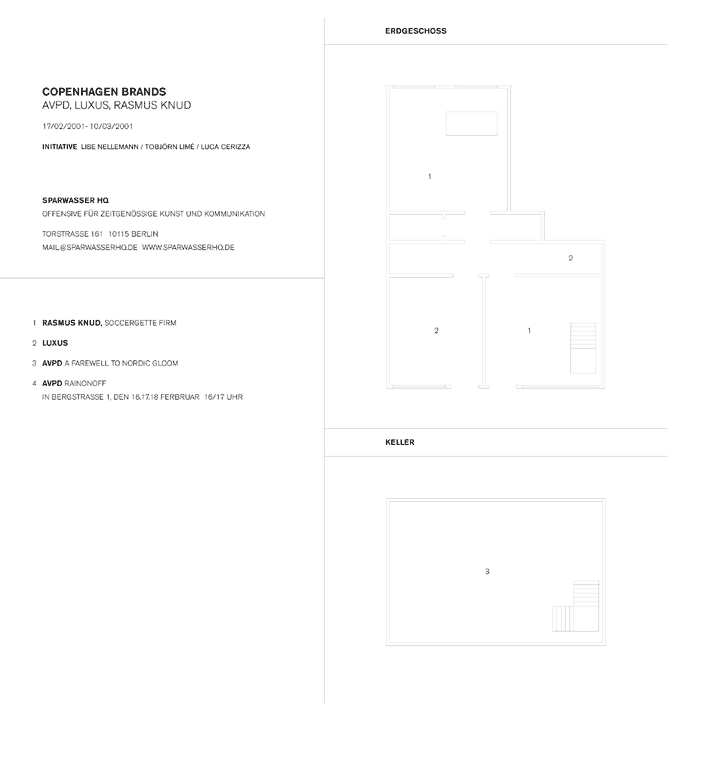Copenhagen Brands
featuring the artist groups AVPD, rasmus knud, and Luxus
February 17. - March 10. 2001
Curated by Solvej Ovesen and Henrikke Nielsen
Branding, advertising, marketing, presentation, service, slogan, logo design, corporate identity these are words and concepts associated with the world of commercial business. They apply also to the artworks by three Copenhagen artist-collaborations, AVPD, Luxus, and rasmus knud, presented in the exhibition Copenhagen Brands at Sparwasser HQ. In Copenhagen Brands, the project is the product, the aesthetic object; the exhibition objects and the individual artists are subsumed, operating under the labels of their respective artist-groups. Ultimately, it is the action and the performance, not the product that are crucial to the concept of Copenhagen Brands.
AVPD employs marketing and economic strategies in the staging of events. The Stockholm Project, for example, consisted of a helicopter flight over Stockholm at Artgenda 1998. In addition to the works exhibited in the project space at Sparwasser HQ, during the first three days of the exhibition, Rainonoff, an artificial rain shower in Bergstrasse, will be turned on at 4 pm and off at 5 pm. In line with former projects, AVPD draws on common myths and symbols, e.g. rain, that are exploited often, as strong metaphor and fascinating phenomena, in popular culture and film. By exposing its technical source, AVPD reveals the rain as a product of film equipment, deflating its otherwise poetic implications.
Luxus operates within the social and service industries. At Luxus' website, www.luxusevents.net, subscribers to Home Hospitality Project can enter their addresses into a database, becoming members of a global network that provides other members with overnight travel accommodations. The project Opgang, meaning staircase, was a fictional staircase in Copenhagen, where people could design and build their own living spaces. Luxus constructs, although not always physically, a framework within which meetings and actions defined by the participants can take place. For example, the floor in one of the Sparwasser HQ's rooms is covered with fresh grass, an invitation to play croquet: luxury and leisure in the exhibition space.
The formation of The Soccergette Firm, the fan club of the fictitious female football team Seven Sisters, is the framework within which rasmus knud explores themes of individual and collective identity. The football world is imitated in their work through representations of pennants, slogans, and a CD with marching songs, presented in context with a history of the turn-of-the-century feminists, the suffragettes. In order to describe the different human relations that make up a community, rasmus knud take as their point of departure popular football culture and its marginalized fraction of female football players. Since 1992, rasmus knud, a loosely structured and partly fictional group of artists, has dealt with similar topics of identity and community; they took part in Manifesta 2000, Ljublana and Monumentum 2000, Nordic Festival of Art, Moss, Norway.
AVPD, Luxus, and rasmus knud unveil preexisting, but partly hidden, social and mental structures in contemporary society. Thus, they cause us to reflect on manners and customs, and to recognize a range of possibilities in relation to other people and situations. Rather than being passive voyeurs or artists performing in the (hermetically sealed off) ivory tower of the art scene, AVPD, Luxus, and rasmus knud intervene directly in the social structure, under the premises laid out by that reality. The goal is not to protest against a hegemonic order, but rather to establish spaces of potential action.
